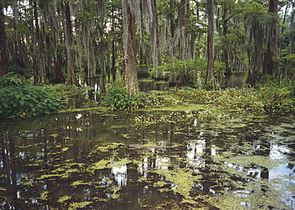Nature Conservation 4/2011 — 4. 11. 2011 — International Nature Conservation
Plesník J.: Atchafalaya Bayou – A Point Where the World Ends

The Atchafalaya Bayou is the largest swamp in the United States, covering 3,200 km2. It is situated in south central Louisiana and harbours nationally significant expanses of bottomland hardwoods, Bald Cypress-Tupelo swamplands, meandering bayous, and back-water lakes.
The Atchafalaya Basin has many commercial uses including commercial fishing, hunting, trapping, logging, oil and gas production and recreational tours. In 1984, the Atchafalaya National Refuge was established there providing a tremendous diversity of habitats for more than 200 species of resident and migratory birds including the biggest heronry in Louisiana and numerous other wild plant and animal species. Baseline mark-release data have been obtained to reveal trends in the Alligator Snapping Turtle (Macroclemys temmincki) there. The region is also known due to Cajuns, an ethnic group consisting of the descendants of Acadian exiles (French-speakers from what is now the Canadian Maritimes). The control of the rivers floods, along with those of the Mississippi River, has recently saved more populated areas in Louisiana from heavy damages. At the same time, particularly cutting off the swamp from the river has been preventing the swamp from functioning as a buffer protecting the entire coast of Louisiana from the effects of hurricanes in the Gulf of Mexico by dissipating their accompanying storm surges. In addition, within almost half of water body sub-segments, the water quality has been seriously negatively affected by various contaminations.

